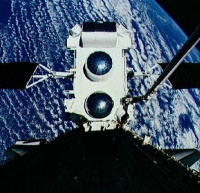Compton Gamma-Ray Observatory
From The Space Library
 | |
| Organization | NASA-Office of Space Science Applications (United States) |
|---|---|
| Mission type | Astronomy |
| Launch date | April 5, 1991 |
| Launch vehicle | STS-37 |
| Carrier rocket | Space Shuttle |
| Launch site | Cape Canaveral, United States |
| COSPAR ID | 1991-027B |
| Mass | 16329.0 kg |
| Experiments | Here |
| Alternate Names | CGRO, GRO, 21225 |
| Nominal Power | 2000.0W |
| Additional Information | Here |
| PDMP Information | Here |
| Telecommunications Information | Here |
| Data Collection | Here |
The Compton Gamma-Ray Observatory (GRO) is one of NASA's four "Great Observatories". GRO's specific mission is to study the sources and astrophysical processes (e.g., nuclear reactions, electron bremsstrahlung, matter-antimatter annihilation, elementary particle producation and decay, Compton scattering, and synchrotron radiation) that produce that highest energy electromagnetic radiation from the cosmos. GRO carries a complement of four instruments that provide simultaneous observations covering over five decades of energy from 0.1 MeV to 30 GeV: the Burst and Transient Source Experiment (BATSE), the Oriented Scintillation Spectrometer Experiment (OSSE), the Imaging Compton Telescope (COMPEL), and the Energetic Gamma-Ray Experiment Telescope (EGRET). The initial phase of the science program consists of a near-uniform survey of the complete celestial sky followed by specific concentrations in later phases; a 6 to 10-year mission lifetime is anticipated. The GRO spacecraft is a 3-axis stabilized, free-flying spacecraft that is capable of pointing at any celestial target for a period of 14 days or more with an accuracy of 0.5 degree. Attitude determination accuracy is 2 arc minutes. If a significant celestial event should occur at some other location, GRO is capable of maneuvering to any orientation, by ground command, within 36 hours. Absolute timing is accurate to 0.1 ms. The observatory has an onboard propulsion system, with approximately 1860 kg of monopropellant hydrazine, for orbit maintenance. Fuel is reserved for a controlled reentry, into a defined area of the Pacific Ocean at mission demise.
